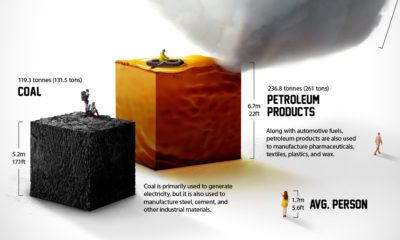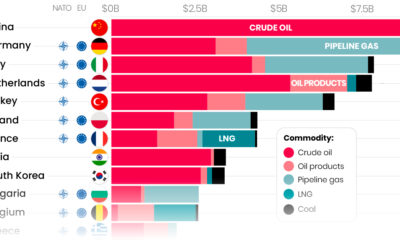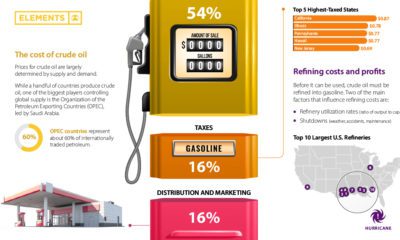Entire economies and nations have been built on the discovery and exploitation of oil and gas, while some nations have misused this wealth─or projected growth just never materialized.
Today’s chart comes to us from research compiled by World Bank economist Jim Cust and Natural Resource Governance Institute economist David Mihalyi and it plots major oil discoveries since 1868.
The 20 Biggest Oil Discoveries
This map includes 1,232 discoveries of recoverable reserves over 500 million barrels of oil equivalent (BOE) From 1868 to 2010. The discoveries cluster in certain parts of the world, covering 46 countries, and are of significant magnitude for each country’s economy. The average discovery is worth 1.4% of a country’s GDP today, based on the cash value from their production or net present value (NPV). Of the total 1,232 discoveries, these are the 20 largest oil and gas fields: The location of these deposits reveals a certain pattern to geopolitical flashpoints and their importance to the global economy. While these discoveries have brought immense advantages in the form of cheap fuel and massive revenues, they have also altered and challenged how nations govern their natural wealth.
The Future of Resource Wealth: A Curse or a Blessing?
A ‘presource curse’ could follow in the wake of the discovery, whereby predictions of projected growth and feelings of euphoria turn into disappointment.
An oil discovery can impose detrimental consequences on an economy long before a single barrel leaves the ground. Ideally, a discovery should increase the economic output of a country that claims the oil. However, after major discoveries, the projected growth sometimes does not always materialize as predicted.
Getting from discovery to sustained prosperity depends on a number of steps. Countries must secure investment to develop a project to production, and government policy must respond by preparing the economy for an inflow of investment and foreign currency. However, this is a challenging prospect, as the appetite for these massive projects appears to be waning.
In a world working towards reducing its dependence on fossil fuels, what will happen to countries that depend on oil wealth when demand begins to dwindle?
Countries can no longer assume their oil and gas resources will translate into reliable wealth — instead, it is how you manage what you have now that counts.
on
Even while political regimes across these countries have changed over time, they’ve largely followed a few different types of governance. Today, every country can ultimately be classified into just nine broad forms of government systems.
This map by Truman Du uses information from Wikipedia to map the government systems that rule the world today.
Countries By Type of Government
It’s important to note that this map charts government systems according to each country’s legal framework. Many countries have constitutions stating their de jure or legally recognized system of government, but their de facto or realized form of governance may be quite different. Here is a list of the stated government system of UN member states and observers as of January 2023: Let’s take a closer look at some of these systems.
Monarchies
Brought back into the spotlight after the death of Queen Elizabeth II of England in September 2022, this form of government has a single ruler. They carry titles from king and queen to sultan or emperor, and their government systems can be further divided into three modern types: constitutional, semi-constitutional, and absolute. A constitutional monarchy sees the monarch act as head of state within the parameters of a constitution, giving them little to no real power. For example, King Charles III is the head of 15 Commonwealth nations including Canada and Australia. However, each has their own head of government. On the other hand, a semi-constitutional monarchy lets the monarch or ruling royal family retain substantial political powers, as is the case in Jordan and Morocco. However, their monarchs still rule the country according to a democratic constitution and in concert with other institutions. Finally, an absolute monarchy is most like the monarchies of old, where the ruler has full power over governance, with modern examples including Saudi Arabia and Vatican City.
Republics
Unlike monarchies, the people hold the power in a republic government system, directly electing representatives to form government. Again, there are multiple types of modern republic governments: presidential, semi-presidential, and parliamentary. The presidential republic could be considered a direct progression from monarchies. This system has a strong and independent chief executive with extensive powers when it comes to domestic affairs and foreign policy. An example of this is the United States, where the President is both the head of state and the head of government. In a semi-presidential republic, the president is the head of state and has some executive powers that are independent of the legislature. However, the prime minister (or chancellor or equivalent title) is the head of government, responsible to the legislature along with the cabinet. Russia is a classic example of this type of government. The last type of republic system is parliamentary. In this system, the president is a figurehead, while the head of government holds real power and is validated by and accountable to the parliament. This type of system can be seen in Germany, Italy, and India and is akin to constitutional monarchies. It’s also important to point out that some parliamentary republic systems operate slightly differently. For example in South Africa, the president is both the head of state and government, but is elected directly by the legislature. This leaves them (and their ministries) potentially subject to parliamentary confidence.
One-Party State
Many of the systems above involve multiple political parties vying to rule and govern their respective countries. In a one-party state, also called a single-party state or single-party system, only one political party has the right to form government. All other political parties are either outlawed or only allowed limited participation in elections. In this system, a country’s head of state and head of government can be executive or ceremonial but political power is constitutionally linked to a single political movement. China is the most well-known example of this government system, with the General Secretary of the Communist Party of China ruling as the de facto leader since 1989.
Provisional
The final form of government is a provisional government formed as an interim or transitional government. In this system, an emergency governmental body is created to manage political transitions after the collapse of a government, or when a new state is formed. Often these evolve into fully constitutionalized systems, but sometimes they hold power for longer than expected. Some examples of countries that are considered provisional include Libya, Burkina Faso, and Chad.













